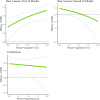Environmental modifiers of RTS,S/AS01 malaria vaccine efficacy in Lilongwe, Malawi
- PMID: 32532234
- PMCID: PMC7291743
- DOI: 10.1186/s12889-020-09039-z
Environmental modifiers of RTS,S/AS01 malaria vaccine efficacy in Lilongwe, Malawi
Abstract
Background: RTS,S/AS01 is the first vaccine against malaria to undergo pilot implementation, beginning in 2019 and vaccinating 360,000 children per year in Malawi, Ghana, and Kenya. The four-dose vaccine is given as a primary three-dose series with a fourth dose given approximately 18 months later. The efficacy of RTS,S/AS01 was variable among the 11 sites participating in the 2009-2014 phase III trial (MALARIA-055, NCT00866619), possibly due to differences in transmission intensity. However, a within-site examination of environmental factors related to transmission intensity and their impact on vaccine efficacy has yet to be conducted.
Methods: We implemented the phase III RTS,S/AS01 trial at the Malawi site, which enrolled 1578 infants (6-12 weeks) and children (5-17 months) living in the Lilongwe District in Central Malawi and followed them for 3 years between 2009 and 2014. A global positioning system survey and an ecological questionnaire were conducted to collect participant household locations and characteristics, while additional data on background malaria prevalence were obtained from a concurrent Malaria Transmission Intensity (MTI) survey. Negative binomial regression models were used to assess whether the efficacy of the vaccine varied by estimated background malaria prevalence, household roof type, or amount of nearby vegetation.
Results: Vaccine efficacy did not significantly vary by estimated malaria prevalence or by roof type. However, increased vegetation cover was associated with an increase in the efficacy of the three-dose primary RTS,S/AS01 series in the 18 months before the fourth dose and a decrease in the efficacy of the primary vaccine series in the second 18 months following, if the fourth dose was not given. Vegetation cover did not alter the efficacy of the fourth dose in a statistically or practically significant manner.
Conclusions: Vegetation coverage in this study site might be a proxy for nearness to rivers or branching, shallow wetlands called "dambos" which could serve as breeding sites for mosquitoes. We observed statistically significant modification of the efficacy of RTS,S/AS01 by forest cover, suggesting that initial vaccine efficacy and the importance of the fourth dose varies based on ecological context.
Trial registration: Efficacy of GSK Biologicals' Candidate Malaria Vaccine (257049) Against Malaria Disease Caused by P. falciparum Infection in Infants and Children in Africa. NCT00866619 prospectively registered 20 March 2009.
Keywords: Africa; Hansen Forest cover; Malaria; Malawi; RTS,S/AS01; Spatial analysis; Vaccine; Vaccine trial.
Conflict of interest statement
ML is a GSK employee and owns GSK shares in the GSK group of companies. The other authors declare no competing interests.
Figures






References
-
- World Health Organization, Global Malaria Programme. World malaria report 2019. 2019.
-
- Tinto H, Otieno W, Gesase S, Sorgho H, Otieno L, Liheluka E, et al. Long-term incidence of severe malaria following RTS,S/AS01 vaccination in children and infants in Africa: an open-label 3-year extension study of a phase 3 randomised controlled trial. Lancet Infect Dis. 2019;19(8):821–832. doi: 10.1016/S1473-3099(19)30300-7. - DOI - PubMed
Publication types
MeSH terms
Substances
Associated data
Grants and funding
LinkOut - more resources
Full Text Sources
Medical

